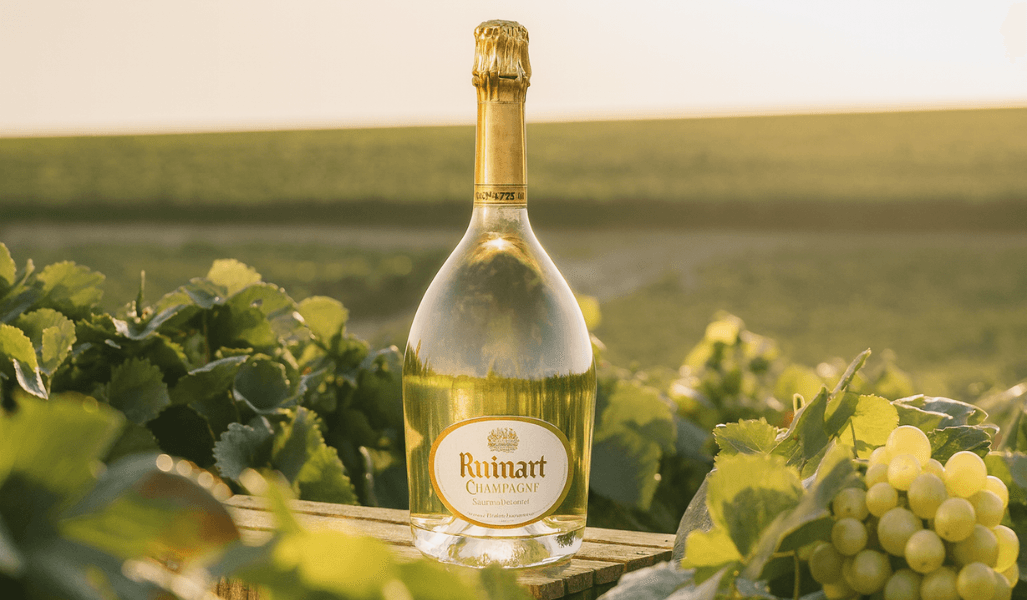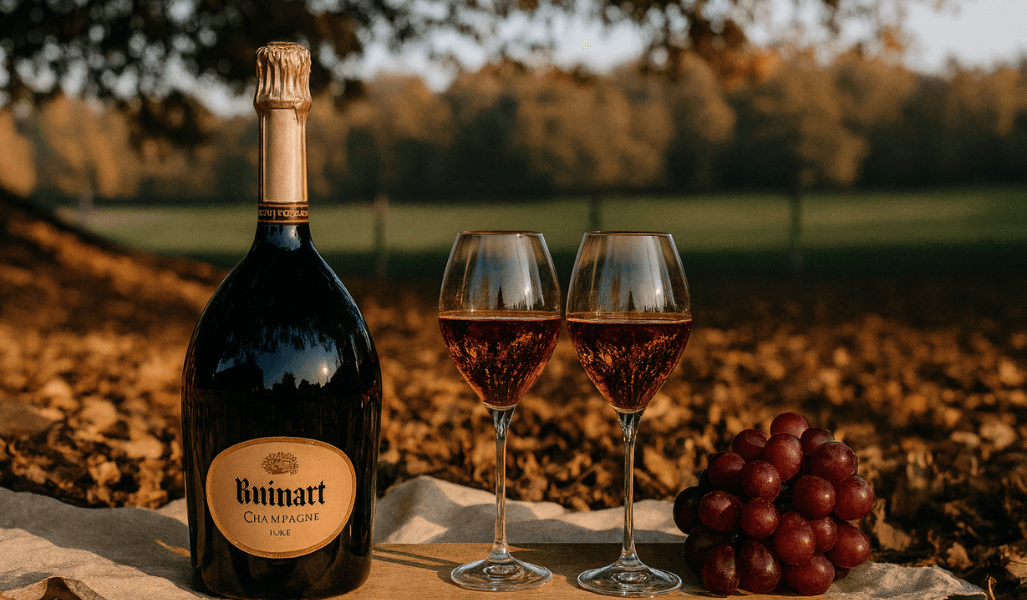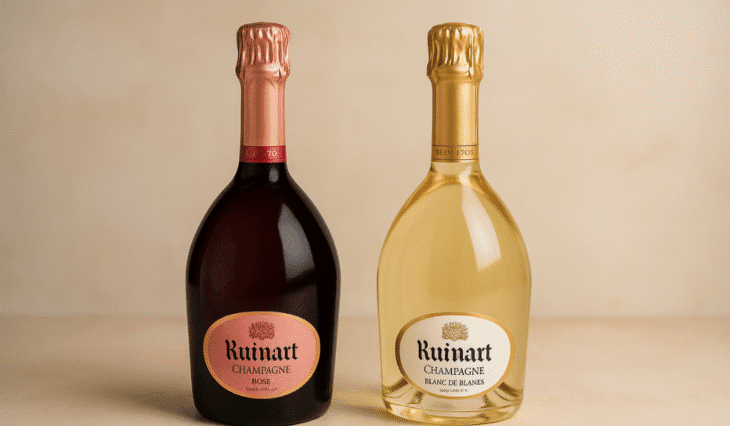Ruinart Rosé vs. Ruinart Blanc de Blancs: Which One Should You Choose
Among the great Champagne houses, Ruinart holds a place of quiet authority. Established in 1729, it stands as the oldest Champagne maison, long before the region became synonymous with celebration. Its philosophy centers on clarity, elegance, and refinement, expressed through a deep respect for Chardonnay. Over the centuries, Ruinart has perfected the harmony between lightness and depth, creating wines that shine with precision and grace.
Within its collection, two bottles define the essence of Ruinart’s artistry: Ruinart Blanc de Blancs and Ruinart Rosé. They share the same heritage yet express it in different ways. Blanc de Blancs reveals purity, luminosity, and mineral freshness, while Rosé unveils warmth, richness, and an embrace of red fruit elegance. Both are magnificent, but each carries its own personality that speaks to mood, pairing, and purpose.
If your taste leans toward finesse, brightness, and subtle mineral character, choose Ruinart Blanc de Blancs. If you are drawn to generosity, texture, and fruit-forward charm, choose Ruinart Rosé. Each bottle captures a distinct emotion within the same spirit of craftsmanship, allowing every moment to feel exceptional.
Key Takeaways
- Ruinart Blanc de Blancs and Ruinart Rosé represent two sides of the same artistry. Blanc de Blancs captures purity, clarity, and finesse through 100 percent Chardonnay, while Rosé blends Chardonnay and Pinot Noir for richness, warmth, and expressive fruit. Both reflect the luminous style that defines Ruinart as the oldest Champagne house.
- Their flavor profiles and moods differ beautifully. Blanc de Blancs offers citrus, pear, and mineral notes with a crisp and elegant finish. Rosé brings red berries, pink grapefruit, and pomegranate, unfolding with creamy texture and depth. The former feels serene and refined, the latter romantic and vibrant.
- Each Champagne suits a different moment. Blanc de Blancs shines in formal celebrations and refined dinners, pairing naturally with seafood and delicate flavors. Rosé fits joyful occasions and intimate evenings, matching richer dishes like duck, salmon, or berry desserts.
- Both age gracefully but evolve in distinct ways. Blanc de Blancs matures slowly, gaining toasted and nutty complexity over time. Rosé evolves toward smoother texture and mellowed red fruit tones, rewarding short- to medium-term cellaring.
- Choosing between them depends on emotion rather than hierarchy. Blanc de Blancs is elegance distilled into light, ideal for those who value precision and purity. Rosé is joy expressed through color and flavor, perfect for those who seek warmth and connection. Either choice offers a taste of Ruinart’s three centuries of craftsmanship and devotion to perfection.
The Ruinart Legacy and Philosophy
Ruinart’s heritage began with a vision rooted in enlightenment and refinement. Founded by Nicolas Ruinart in Reims, the maison was inspired by his uncle, Dom Thierry Ruinart, a Benedictine monk who foresaw Champagne’s future as a wine of distinction. From the start, Ruinart devoted itself to Chardonnay, the varietal that best expressed finesse, freshness, and brilliance.
Every aspect of production, from vineyard selection to ageing in the historic chalk cellars known as Les Crayères, reflects this devotion to clarity and light. Ruinart’s cellars, carved deep into ancient chalk quarries, maintain natural humidity and temperature, allowing the wines to mature slowly and gracefully. This environment contributes to the elegant texture and lasting freshness that define both Blanc de Blancs and Rosé.
Understanding Ruinart’s heritage reveals that these two Champagnes are not simply different cuvées but complementary expressions of the same idea. Blanc de Blancs embodies transparency and precision, while Rosé adds emotional depth and aromatic generosity.
Meet the Wines: Two Distinct Expressions of Craftsmanship
Ruinart Blanc de Blancs – The Essence of Elegance

Ruinart Blanc de Blancs is crafted entirely from Chardonnay grapes, many drawn from Premier Cru vineyards in the Côte des Blancs and Montagne de Reims. These regions are known for chalk-rich soils that give the wine its luminous character and delicate minerality.
The first impression is one of brilliance. The color shimmers with pale gold hues, and the bubbles form a fine, persistent stream. The aromas rise gently, opening with lemon zest, white flowers, and hints of fresh peach. As the wine breathes, subtle notes of pear, almond, and chalk emerge, revealing both freshness and depth.
On the palate, Blanc de Blancs is crisp and vibrant, yet never sharp. Its texture is creamy and harmonious, with flavors of citrus and stone fruit balanced by a clean mineral finish. Each sip leaves a sensation of lightness and clarity, a hallmark of Ruinart’s Chardonnay craftsmanship.
Tasting Profile
- Aroma: Citrus, white flowers, pear, peach, and chalk
- Palate: Elegant, bright, and pure with fine bubbles and lasting freshness
- Food Pairing: Oysters, sashimi, crab, scallops, citrus salads, and young cheeses
Blanc de Blancs shines as an aperitif but also enhances dishes that mirror its precision. It is Champagne at its most graceful, a wine that feels timeless in its restraint and refinement.
Ruinart Rosé – The Expression of Generosity and Depth

Ruinart Rosé combines the freshness of Chardonnay with the power of Pinot Noir, a blend that achieves balance between delicacy and structure. A portion of the Pinot Noir is vinified as red wine before blending, giving the Champagne its gentle pink color and subtle tannic backbone.
The color is a luminous coral with glints of copper. The aromas are immediately engaging, filled with red berries, pink grapefruit, and a soft hint of pomegranate. Beneath the fruit lies a quiet layer of spice and floral nuance, adding intrigue and complexity.
On the palate, Ruinart Rosé unfolds with smoothness and generosity. Flavors of raspberry and wild strawberry mingle with orange zest and a faint touch of mint. The mouthfeel is creamy and full-bodied yet remains refreshing, ending with a long, elegant finish.
Tasting Profile
- Aroma: Red berries, pink grapefruit, pomegranate, and gentle spice
- Palate: Rich and expressive with silky bubbles and balanced freshness
- Food Pairing: Duck breast, salmon, tuna, charcuterie, and berry desserts
Ruinart Rosé is a Champagne that feels like celebration itself. It carries the same precision as Blanc de Blancs but wrapped in warmth and emotion. It is the wine you choose when you want conversation to linger and the evening to unfold slowly.
Key Differences at a Glance
| Element | Ruinart Blanc de Blancs | Ruinart Rosé |
| Grapes | 100 percent Chardonnay | Chardonnay and Pinot Noir |
| Color | Pale gold | Delicate pink with copper glints |
| Aroma | Citrus, white flowers, pear | Red berries, pink grapefruit, spice |
| Palate | Crisp, mineral, luminous | Creamy, fruit-forward, rounded |
| Mood | Elegant, precise, refined | Romantic, expressive, generous |
| Best With | Seafood, sushi, light cheese | Duck, salmon, berry desserts |
| Ideal Occasion | Aperitif, formal dinner, gifting | Celebrations, romantic evenings |
Blanc de Blancs reveals purity and structure, ideal for those who love refinement and clarity. Rosé brings fruit, warmth, and texture, appealing to those who enjoy expressiveness and charm.
How They Taste Side by Side

Enjoying both in one sitting brings their contrasts to life. Blanc de Blancs begins with brightness, unfolding with clean acidity and refined minerality. It leaves a sensation of lightness that almost disappears into air. Rosé follows with richer tones, offering fruit, creaminess, and a deeper, more sensual rhythm.
Blanc de Blancs feels like morning sunlight filtered through white curtains, pure and invigorating. Rosé feels like twilight over a summer garden, glowing with warmth and color. One refreshes, the other comforts. Both captivate in their own way.
Which One Fits Your Occasion
- For formal celebrations or elegant dinners, Ruinart Blanc de Blancs stands out. Its clarity complements sophisticated dishes and refined company. It speaks softly but leaves a lasting impression.
- For romantic evenings or creative gatherings, Ruinart Rosé is the natural choice. Its fruit-forward profile and softness make it approachable and memorable, the kind of wine that turns moments into memories.
- For gifting, Blanc de Blancs offers timeless sophistication, while Rosé conveys emotion and thoughtfulness. Collectors may prefer Blanc de Blancs for its ageing potential, while those who value immediacy of flavor will delight in Rosé’s charm.
Your choice depends on what you wish to express. Blanc de Blancs is elegance distilled into light. Rosé is joy captured in color and flavor.
Serving and Enjoying
Serve both wines between 8 and 10 degrees Celsius to reveal their full complexity. Choose tulip-shaped glasses to allow the aromas to expand and avoid tall flutes that restrict scent.
Blanc de Blancs pairs beautifully with shellfish, lobster, and delicate white fish. The citrus and mineral tones enhance the freshness of seafood dishes.
Rosé complements bolder flavors such as roasted duck, grilled salmon, and berry desserts. Its richness matches spice and sweetness without overpowering the palate.
When served side by side, they invite discovery. The contrast between their characters deepens appreciation for each, turning an ordinary tasting into an experience of texture, aroma, and emotion.
Buying and Storing Tips
Ruinart’s wines are available at reputable wine boutiques and luxury online retailers. Always check for proper storage conditions and authenticity seals.
Store bottles horizontally in a dark, quiet place with a consistent temperature of 10 to 12 degrees Celsius. Champagne is sensitive to light and vibration, so avoid exposure to sunlight or frequent movement.
Non-vintage Blanc de Blancs can age gracefully for up to five years, developing notes of brioche, almond, and honey. Rosé evolves toward smoother texture and deeper fruit tones, rewarding those who enjoy a touch of maturity in their glass.
To complete your tasting experience, visit our collection of Champagnes and discover bottles that perfectly complement your next celebration.
Choosing Between Two Expressions of Perfection

Ruinart Blanc de Blancs and Ruinart Rosé embody two interpretations of Champagne artistry. Blanc de Blancs celebrates light, precision, and balance, appealing to those who appreciate purity and finesse. Rosé embraces generosity, depth, and warmth, resonating with those who love expressive and vibrant wines.
There is no single answer to which is better. Each serves a different purpose, and both reflect the same dedication to excellence. Blanc de Blancs brings clarity to quiet evenings and formal gatherings. Rosé adds color and emotion to joyful celebrations.
Whichever you choose, you are tasting the essence of nearly three centuries of craftsmanship. Every bubble carries Ruinart’s heritage of patience, artistry, and devotion to perfection. The best way to decide is not to compare but to experience both and discover which one feels like your own reflection in a glass.
At California Champagne Sabers, we celebrate that same spirit of artistry with our collection of Champagne sabers designed for timeless celebrations, and a curated selection of fine Champagnes that transform every toast into an experience of elegance and joy.
Frequently Asked Questions
What does Blanc de Blancs mean?
Blanc de Blancs means “white from white.” It refers to Champagne made entirely from white grapes, usually Chardonnay. This is significant because many Champagnes are blends of both white and black grape varieties. Chardonnay gives Blanc de Blancs its refined character, purity, and brightness. It is known for fresh aromas of citrus, green apple, and white flowers, balanced by soft minerality and smooth bubbles. As it matures, it develops richer notes of brioche, honey, and almond while maintaining a lively freshness. Ruinart Blanc de Blancs is one of the finest examples of this style, representing precision and elegance in its purest form.
Is Ruinart Rosé sweeter than Blanc de Blancs?
Not necessarily. Both have similar levels of sugar, but they differ in how they feel on the palate. Ruinart Rosé seems rounder and fruitier because of the Pinot Noir that adds flavors of red berries and pomegranate. This creates a sensation of gentle sweetness, even though the wine remains balanced and dry. Blanc de Blancs, made solely from Chardonnay, feels leaner and more refreshing because of its crisp acidity and mineral undertones. The difference is not about sugar but about style. Rosé expresses warmth and fruit, while Blanc de Blancs reflects purity and freshness.
Can they age in the cellar?
Yes, both age beautifully, though in different ways. Blanc de Blancs has high natural acidity that allows it to evolve slowly over time. With several years of ageing, it develops layers of brioche, toasted nuts, and soft vanilla while retaining its luminous freshness. Ruinart Rosé also benefits from ageing but shows its changes more quickly. Over time, its red fruit aromas mellow into dried berries and candied citrus, while the texture becomes creamier and more refined. Ideally, Blanc de Blancs can be cellared for up to eight years and Rosé for five to six years. Both should be stored on their side in a cool, dark, and still place, ideally around ten to twelve degrees Celsius.
Which is better for gifting?
The choice depends on the sentiment you wish to convey. Blanc de Blancs is timeless and sophisticated, ideal for formal occasions, weddings, or business gifts. Its golden hue and refined taste speak of elegance and restraint. Rosé feels more personal and expressive, suited for romantic occasions, anniversaries, or celebrations shared among close friends. Its soft pink color and rounded flavor convey warmth and thoughtfulness. Both wines show exquisite craftsmanship, but Blanc de Blancs appeals to classic refinement, while Rosé evokes emotion and intimacy.
What food pairs best with each?
Ruinart Blanc de Blancs pairs beautifully with foods that highlight its freshness and precision. Seafood is an excellent choice, especially oysters, scallops, and crab. It also enhances dishes such as sushi, ceviche, and light pastas with lemon or herbs. Its acidity and minerality balance creamy textures, making it perfect with soft cheeses like burrata or young goat cheese.
Ruinart Rosé matches more expressive dishes. The fruit and body of the wine complement roasted poultry, grilled salmon, tuna tartare, or duck breast with berry glaze. It also pairs elegantly with Asian cuisine that carries subtle spice. For dessert, it harmonizes with strawberry tart, raspberry sorbet, and chocolate with red fruit notes.
When serving both at a dinner, start with Blanc de Blancs to awaken the palate, then move to Rosé for richer courses or dessert. This creates a natural flow of freshness leading to fullness, a reflection of how Ruinart’s artistry evolves across its Champagnes.
